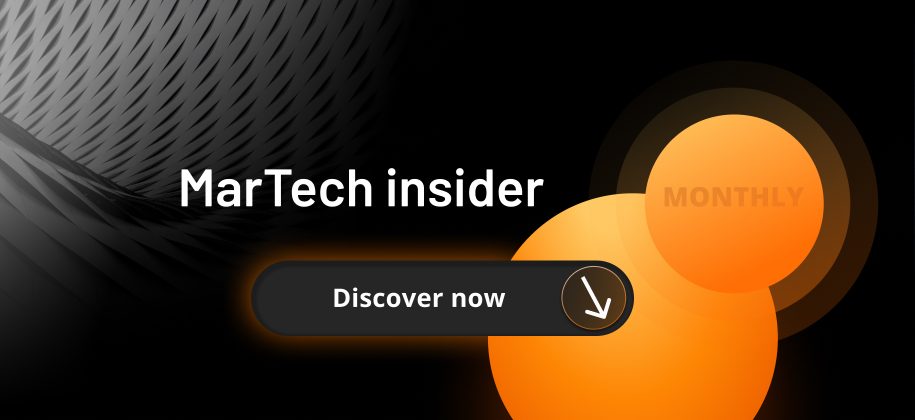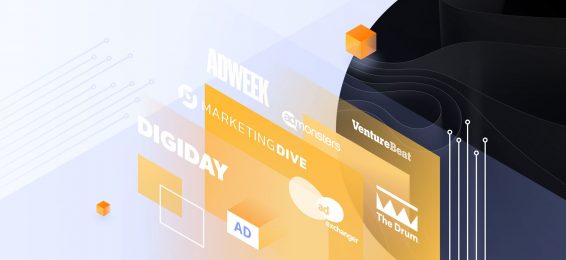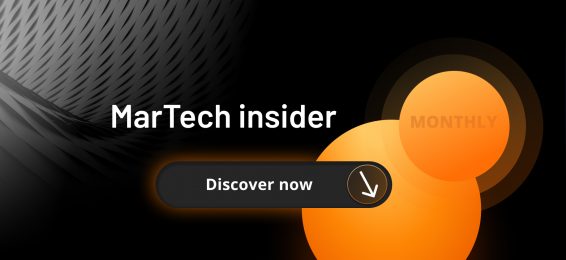| Getting your Trinity Audio player ready... |
Welcome to the summer edition of MarTech Insider, a newsletter exploring top news stories and discussions.
In the AdTech and MarTech world, summertime means no holidays or reprieves—just ask the folks who were at Cannes, where even the parties are all about business. From major acquisitions and strategic partnerships to financial surges and groundbreaking new tools, June and July were packed with significant events. In today’s edition, we cover breaking news, widely discussed announcements, and comments from industry experts.
Follow Xenoss MarTech Insider to get monthly updates on AdTech and MarTech news.
Let’s dive in!

For this digest’s big story, we chose to highlight a major and rare event in the CDP industry—the acquisition—which could serve as a wake-up call for all vendors. The acquisition shakes up the quiet CDP industry, signaling a trend toward consolidations and comprehensive tech stacks.
BlueConic ’s acquisition of Jebbit is a bold move, underscoring their dedication to a single, integrated platform. David Raab, founder of the CDP Institute, pointed out that this commitment contrasts with vendors piecing together components in cloud data warehouses built outside the CDPs. With the acquisition of first-party data-capture and experience-creation software, BlueConic aims to become the premier “operating system for customer data.” The combination of their technologies positions BlueConic to lead the market in integrated customer data solutions.

This acquisition jolts the relatively stagnant CDP market, where major acquisitions had been few and far between:
- Cheetah Digital by Marigold. Americas. Merged with CM Group in 2022
- Contactlab. EMEA. Acquired by Growens s in 2022.
- Ensighten, a CHEQ company. Americas. Acquired by CHEQ in 2022.
- Invenna. EMEA. Merged with Human Inference in 2023.
- Neodata Group. EMEA. Merged with Adabra to form Blendee in 2023.
- TheDataTeam. APAC. Acquired by Lentra in 2022.
CDPs that evolve into larger, more comprehensive vendors face challenges as they expand services without entering media-buying territory. This shift is part of a broader trend among some CDPs and other vendors, like IAS and DoubleVerify, who are slowly edging toward ad-buying. Beyond the competitive tension of branching into new areas like analytics and data clean room services, BlueConic and other CDPs also face stiff competition from major platform players. Cloud giants like Snowflake claim they can replace CDPs, but they are typically designed for IT departments rather than being integral to marketing teams.

BlueConic’s move to buy Jebbit is about more than just expanding their toolkit. Jebbit’s interactive tools, like quizzes and surveys, are set to supercharge BlueConic’s data segmentation and activation, leading to richer customer insights. Tom Coburn, Jebbit’s CEO, emphasized the game-changing potential of this integration for customer profiling. While CDPs usually beef up with predictive analytics and personalization, BlueConic already has those bases covered. By adding Jebbit’s data capture features, they’re tapping into a fresh growth area. As privacy concerns tighten restrictions on other data sources, capturing “zero party” data directly from customers is becoming the name of the game.
This move aligns with a broader trend of building comprehensive customer profiles through direct interactions. Integrations like this will be crucial for keeping marketing strategies data-driven and effective. BlueConic and Jebbit will set a new standard in the CDP landscape, offering integrated solutions that directly address modern data challenges.
We also asked Jon Walsh, the founder of JobsInAdtech.com, The Adtech Chat Community, and Xenoss Brand Ambassador, for his opinion on this major industry shakeup. Here is Jon’s breakdown of the deal and the implications for the Jebbit brand and BlueConic’ strategy.
Jon Walsh, founder of JobsInAdTech and The AdTech Chat, shares his thoughts on BlueConic’s acquisition of Jebbit

Blockgraph is transforming pharma TV ads. Partnering with Datavant, they aim to enhance ad measurement and targeting while respecting privacy. Blockgraph is staying focused on measurement because targeting individual households based on claims or patient data poses privacy risks. However, buyers can anonymously measure “script lift” at the household level. Data matches between Datavant and Blockgraph undergo additional anonymization before reporting to advertisers. This improved measurability makes pharma campaigns more effective and appealing to advertisers, publishers, and distributors.

Netflix’s revenue surge: From small stream to big splash
In July, Netflix announced its Q2 2024 financial results, revealing a significant 17% year-over-year increase in overall revenue. The report also highlighted a 34% quarter-over-quarter growth in ad-supported tier subscriptions and a 16% year-over-year increase in overall paid memberships. Netflix’s move to in-house ad tech aims to attract more brands and improve ad targeting, personalization, and measurement. Co-CEO Greg Peters emphasized that this control should enhance the ways buyers can purchase Netflix inventory, including through platforms like The Trade Desk and Google ’s DV360. These enhancements respond to advertiser demands and aim to effectively monetize Netflix’s rapidly growing ad-supported membership base.

Apple’s News flash: Taboola strikes global deal to sell ads for Apple
Apple is teaming up with Taboola to bring native ads to Apple News and Apple Stocks apps across the US, UK, Canada, and Australia. Taboola, a content recommendation giant, will handle the native ad space within the main feeds and articles, marking a significant step for Apple’s growing ad business, which is set to hit $10.34 billion this year. Apple’s ad ambitions are clear: They need a demand booster, and Taboola is stepping in for now. This partnership follows Apple’s previous exclusive deal with NBCUniversal, which is still an authorized reseller in the US and UK.

Outbrain and Teads: A union of equals?
Outbrain is set to acquire Teads, the video monetization firm owned by Altice Group, in a deal worth around $1 billion. This move aims to transform Outbrain into an “end-to-end, full-funnel platform for the open internet,” expanding its reach into the lucrative CTV space. With this acquisition, Outbrain gains access to TV and video publishers, potentially elevating its standing in the ad tech industry.



Roku launches Roku Exchange
Source: Roku, June 12, 2024
Roku ‘s move to introduce the Roku Exchange signals a significant shift in the CTV advertising landscape. For a long time, Roku has tried to carve out its niche as a walled garden, hoarding valuable data and inventory to build an exclusive ecosystem. However, the tides have turned, and the financial pressures are mounting.
Opening up their data and inventory to the programmatic marketplace is a savvy, albeit necessary, pivot. By pulling back the curtain on their data, Roku not only appeases the growing demands for transparency from advertisers but also sets the stage to reel in more programmatic spend. It’s a classic case of adapting to survive. With agencies and advertisers eager to reduce their reliance on multiple ad tech intermediaries, Roku’s strategy might just pay off by consolidating ad spend within its own ecosystem.
What’s more intriguing is the potential long-term play here. While this move dismantles some of the walls Roku built, it might just pave the way for a new approach. By integrating closely with DSPs and SSPs, Roku could be positioning itself to become a central hub in the ad tech space, bridging gaps between buyers and sellers more efficiently than ever before.
In the short term, everyone wins. Roku boosts its revenue, advertisers get more bang for their buck with better data and transparency, and the industry edges closer to a more unified, less fragmented ad-buying process. It’s a win-win scenario that could very well reshape the future of CTV advertising.

Pinterest introduces new AI tools for creative and performance (Pinterest)
Pinterest ‘s new AI tool, Performance+, simplifies ad campaign setup and boosts performance, similar to Meta Advantage+ and GooglePerformance Max. Early tests show a 10% improvement in cost per acquisition and a 50% reduction in setup time. Despite concerns over ad transparency, Pinterest’s brand-safe reputation reassures marketers. Pinterest Performance+ leverages the latest AI and automation features, with the inclusion of Ad Labs for testing innovative ad tools.


Paramount Advertising launched self-service platform powered by DanAds (Next TV)
Paramount Advertising has rolled out its self-serve ad platform, Paramount Ads Manager, targeting small and mid-sized businesses. This tool lets advertisers create, manage, and track commercials on Paramount Plus and Pluto TV. Unique features include self-service creative tools and AI-powered video production. The platform converts social media assets into TV ads and offers robust reporting tools.


In June and July, AdTech industry leaders were discussing:
🔸Spark Ninety’s infographic highlighting the opportunities within the “retail video” ecosystem.
Stephen Adshead, Founder and Director of Spark Ninety, shared the company’s analysis based on advisory work, highlighting emerging opportunities with top-level initial estimates. Commentators pointed out the significant noise and confusion surrounding retail media. They emphasized the need for a clearer breakdown of retail media opportunities and their market size. This includes aspects like in-store video advertising, retail data matching with media owner data, and sponsored products on platforms such as Amazon and TikTok.
🔸IAB’s annual Digital Video Ad Spend & Strategy report
Paul Gubbins , former VP of CTV Strategy & Marketing at Publica by IAS, shared a post highlighting that 75% of CTV transactions are programmatic. This sparked a debate, with some pointing out conflicting data, but in the end, everyone agreed to clear up the definition of “programmatic.”

🔸 Google’s U-turn on third-party cookies
After Google announced that third-party cookies would remain operational in Chrome indefinitely, reversing their decision to deprecate them by 2025, there were plenty of disgruntled reactions, insightful analyses, and solid action plans. But, true to form, the AdTech community also churned out some hilarious memes.

Switching gears back to the CTV discussion, the latest AdImpact’ estimates show a significant rise in political advertising revenues, driven by increased spending on Connected TV platforms.

This growth reflects a broader trend towards digital and streaming media as key channels for reaching voters. With CTV becoming a central part of political campaign strategies, it’s clear that advertisers are recognizing the platform’s potential to engage audiences more effectively. These projections underscore the shifting dynamics in media consumption and the importance of adapting to new advertising landscapes.
Discover more about the emerging trends in CTV in our latest analysis >>>

During the June-July period, our Cannes activities were filled with exciting firsts. We co-sponsored an event with Lumen Research Ltd, StackAdapt, Adimo, and Exibe and launched a podcast with industry experts. We had productive discussions with many AdTech professionals and shared our experiences on the Xenoss Blog. Every year in Cannes, we bring new opportunities, inspiring ideas, and valuable connections.
To stay up to date on the upcoming AdTech events, check out our AdTech event calendar.


This wraps up our newsletter. As we gear up for Programmatic I/O, we anticipate a ton of discussions and insights in the August edition. We’ll keep you informed every step of the way, so be sure to follow Xenoss MarTech Insider to stay updated.


